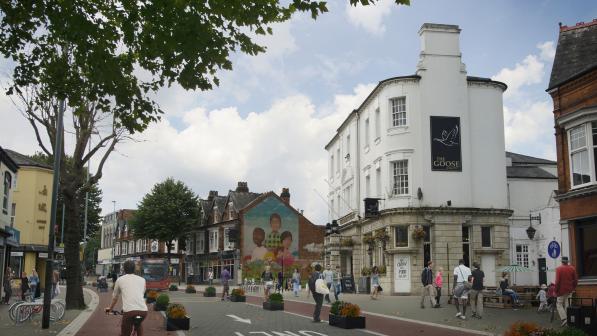Government's new Investment Strategy lacks cash, but we must make the best of it

The Government's long-awaited unveiling of England's Second Cycling and Walking Investment Strategy (CWIS2) on Wednesday (6 July 2022) went almost unnoticed.
That is, largely because of wider political events this week. But it also reflects the fact that it says little that we didn't know already.
It is arguable that CWIS2 doesn't even meet the legal requirements of a CWIS. It spells out the objectives to be achieved and the financial resources to be made available for achieving those objectives (as required by the Infrastructure Act 2015).
However, there is still a glaring mismatch between the increases in cycling and walking the Department for Transport (DfT) is aiming to achieve, and the funding available for doing so.
Unfortunately, the law does not clearly stipulate that the resources available must be sufficient to meet the objectives. That's something I hope we can address when the Government publishes its Transport Bill later this year.
This mismatch creates a real risk for the newly born body Active Travel England. Cycling UK has strongly welcomed its creation, as well as the appointments of Chris Boardman as its commissioner, Danny Williams as its chief executive and other key staff. We know many of them well and respect them a great deal. I and other colleagues look forward to working with them, old and new faces alike.
However the gap between the funding available and what ATE is expected to do with it may turn out to be a poisoned chalice - although I obviously hope to be proved wrong.
Objectives for 2025 and beyond
Some of the CWIS2 objectives have been carried over from the firstCycling and Walking Investment Strategy (CWIS1) – notably the ambition to double cycling 'stages' from 0.8bn in 2015 to 1.6bn in 2025 (a 'stage' can either be a whole trip or part of a trip, for example the cycling portion of a trip that is mainly made by train).
The objective to increase walking as a proportion of trips to school remains unchanged, although the objective to increase walking overall has been strengthened, thanks to lobbying by walking charity Living Streets and allies, including Cycling UK. It has gone up from 300 walking stages per person annually to 365 stages (effectively one walking trip per person per day).
There are also two new longer-term objectives, namely:
- to increase the percentage of short journeys in towns and cities that are walked or cycled to 50% in 2030 and to 55% in 2035; and
- to deliver a world-class cycling and walking network in England by 2040.
These are based on commitments initially set in the Government's excellent Gear Change vision for cycling and walking, and reiterated in its Transport Decarbonisation Plan and Net Zero Strategy.
A terrible one-word addition
Unfortunately, DfT has inserted the word "short" into the first of these objectives. It has incidentally also set a related shorter-term objective for the percentage of short urban journeys that are walked or cycled to 46% in 2025, from a pre-pandemic level of 42%.
It has also defined "short journeys in towns and cities" as journeys of under five miles that both begin and end in a town or city (see the CWIS Progress Report to Parliament, published at the same time as CWIS2).
When DfT first unveiled this target in Gear Change – without the word short – we made no fanfare about it. That was because DfT could not explain to us how it was to be defined or measured. We therefore had no way of knowing whether it was a hugely ambitious target or an entirely pointless one (as I explained towards the end of this blog).
The new definition, and the inclusion of the word short, are very regrettable steps backwards. Not only do they suggest a rather low level of ambition, but they also suggest that the available funding will continue to be concentrated largely in urban areas.
It is true that short urban trips are the most easily switchable to cycling and walking, and this has the greatest benefits in terms of tackling congestion, road danger and pollution.
Given that plenty of local politicians have yet to be convinced of the economic case for investing in cycling and walking (despite the Government's own overwhelming evidence on this), we still need to produce data that cycling and walking schemes deliver real tangible benefits.
Yet there is also a growing recognition among policy-makers of the climate benefits of cycling. Meanwhile the Government has recently allocated £8m to support the uptake of electrically assisted cycles (or e-bikes), through the Cycling made e-asy programme being delivered by Cycling UK and partners.
Evidence from the Netherlands indicates that the average trip on an e-bike is about 60% longer than the average trip on a conventional pedal cycle. E-cycles could significantly increase the contribution of cycling to tackling the climate crisis, by enabling people to switch from cars for longer or hillier journeys, and in more rural areas.
There is still a glaring mismatch between the increases in cycling and walking the Department for Transport is aiming to achieve, and the funding available for doing so
Roger Geffen, Cycling UK policy director
Transport minister Trudy Harrison has repeatedly spoken of her ambition to promote cycling in rural areas, such as her own constituency of Copeland in Cumbria, and the increased funding now available for cycling and walking really ought to be supporting this. Yet her officials have now set an objective in CWIS2 which will steer the money back towards the towns and cities.
This is precisely the wrong moment to reinforce the perception of many rural councils that promoting day-to-day cycling and walking is only really viable in urban areas – and anyway, they wouldn't get Government funding for cycling and walking even if they tried.
In smaller towns, the cars you see are much more likely to be making a trip that starts or ends outside that town. So what puts people off switching from driving to cycling isn't the conditions on that town's streets, but the far worse conditions on the single-carriageway A or B roads linking that town to other nearby towns and villages.
If we are to maximise specifically the climate benefits of cycling – and especially of e-bikes – we need to channel more of the funding into cycling and walking networks which enable people to take up cycling for journeys of around five-eight miles. Hence the new CWIS2 objective relating to short trips is entirely counterproductive.
And the funding?
So, having said that CWIS2 contained very little new news, how come I just mentioned increased funding?
Well, it's not really new news. The allocation of £2bn of ring-fenced funding for cycling and walking over the five years up to March 2025 is still there. Mind you, I'm puzzled as to why the amount allocated for the period of CWIS2 itself (the last four of these years) seems to be just under £1.3bn (or £1.298bn to be precise), given that only £250m of ring-fenced funding was allocated in the first year 2020/1. Where has the other £450m gone?
Anyway, the only new news is an estimate of the amount of non-ring-fenced funding that "may" also be available to meet the CWIS2 objectives over this four-year period. In addition to that £1.298bn, DfT also expects that £2.526bn will be available from wider DfT programmes (such as National Highways' Designated Funds programme, Local Transport Plan funding) and from other Government departments (for example the Levelling Up Fund).
Hence the Government estimates the total amount to be invested under CWIS2 at £3.784bn. We shall see.
Hopes and disappointments
DfT made a similar split between ring-fenced and non-ring-fenced funding in CWIS1. It consisted of £314m of ring-fenced funding and £1.2bn of non-ring-fenced funding to cover the five-year period 2016/7 to 2020/1.
However, DfT now estimates that, in practice, it managed to secure £2.931bn of non-ring-fenced funding, bringing the total spending under CWIS1 to £3.245bn. It is testament to the dedication of DfT's cycling and walking team that they have done so well on securing non-ring-fenced funding for cycling and walking. This amounts to an annual average of £13.80 per person outside London – although it was just £1.33 if we only count the ring-fenced funding.
The equivalent figures for CWIS2 amount to about £19.90 per person per year, or £6.90 if we only count the ring-fenced funding.
It is clear that funding has increased since CWIS1 was announced in 2017, with ring-fenced funding increasing roughly six-fold. That is real progress.
However, even if we include the non-ring-fenced funding, England is now spending less than £20 per person annually, which means it's still lagging behind the levels of ring-fenced spending in Wales (£75m or £23.66 per person in 2021/2) and Scotland (£155m or £21 per person annually in 2021/2, rising to £320m or £58.50 per person in 2024/5).
We also know that the Government is still sitting on evidence (despite repeated promises to publish it) that meet its 2025 objectives would require an average of £1.2bn to £1.6bn annually – or about £25-£34 per person – starting in 2020.
I suspect that the rate of spending needed to deliver "world -class cycling and walking network by 2040" will require an even bigger uplift from current levels. At current rates of spending, Scotland is going to achieve this goal a long time before England does.
Reasons to stay hopeful
Despite frustration at how much further we still need to go on funding, there are reasons to remain hopeful:
The risk is that ATE itself proves to be inadequately resourced to fulfil everything that is expected of it.
Neither ATE nor the new Cycling Infrastructure Design guidance would be there had they not been strongly championed by Andrew Gilligan. Gilligan was Boris Johnson's cycling czar when he was Mayor of London and then his transport special advisor in Downing Street.
Johnson's resignation, announced even as I've been writing this blog, is likely also to lead to Gilligan's departure from No10. If so, we must hope that ATE can survive and thrive without him. We owe him a big debt of gratitude for the progress made over the past two years.
A final message
CWIS2 was published while I and other colleagues were in Sheffield for this year's Cycle City Active City conference. After two years in which this annual event could not take place, it was good to meet up again with a few hundred people involved in cycle policy, planning and delivery in the UK, from local and national government to campaigners, researchers and cycling businesses.
In the final plenary session, my plea to delegates was that we must now make the most of the funding available, however inadequate it may be. DfT's admirable cycling and walking team would also doubtless have wanted to set out a much stronger CWIS, had it not been for the 'dead hand of the Treasury'.
The Government's next Spending Review is probably only 2twoyears away, and there will need to be a third CWIS by 2025. So DfT officials will be looking to councils to provide evidence to help them convince the Treasury that the CWIS2 funding was spent cost effectively, and that much more is needed for CWIS3.
Cycling UK will play our part in helping them do this, not least by briefing our local Cycle Advocacy Network volunteers to engage constructively with councils in developing their cycling and walking networks and plans, and making sure these are incorporated into Local Plans (which guide new developments) and Local Transport Plans.
After all, the crises of congestion, air pollution, physical inactivity and the climate won't wait while the funding catches up. It is in everyone's interests that what is now there is spent well. We all need to pull together to ensure this.



